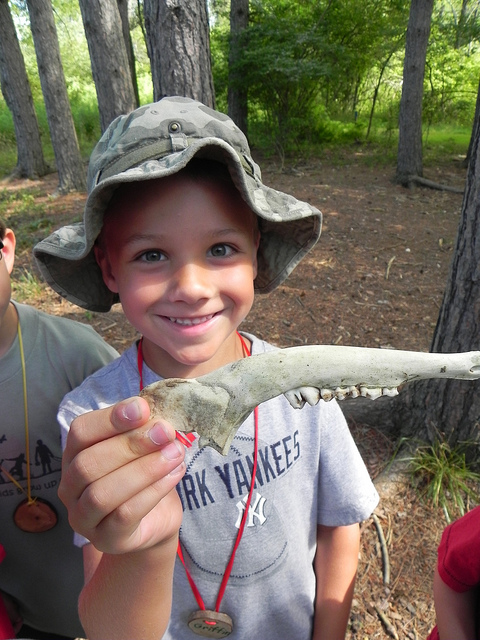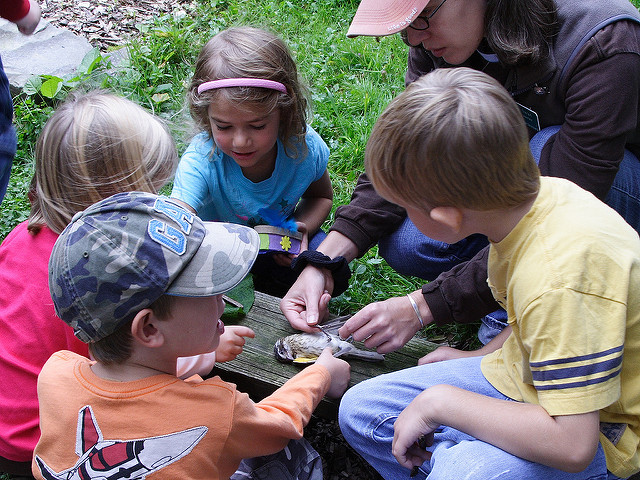I have a sign that says “if people bring you dead things and it gets you excited, you might be a naturalist.” It is part of campaign that the National Association for Interpretation is running, but that one made me laugh, and is quite accurate so I printed it and hung it up where I regularly see it. If that seems like a strange sentiment to you, well, then you might not be a naturalist.
Dead things spark curiosity. True, they may also be gross. Where else, though, do you get to investigate and explore an animal that closely? To be that tied to the natural forces that govern life? And even when you do get the chance, like at bird banding for instance when the banders let people hold the birds, studying the animal closely takes second chair to marveling at the life you’re holding, not concerned with death at all.

Came across a dead weasel, examining for clues.
Imagine, if you will, a dead bird. The means of death is less important than the fact that you are in the presence of this small, feathered body once alive. You can observe the feather patterns from wing to tail to body – perhaps even compare the patterns to feathers you have seen at other points in your life, differences and similarities. You may think to yourself “I didn’t know they were SO yellow.” With a hand lens you can investigate the barbs on the feathers that let them “zip” back together. The intricate details are nature’s art – scale patterns on the legs, the color spectrum of the beak, the soft curve of the talons.
Perhaps you find a dead snake. Again, the investigations becomes mesmerizing as the scales align in almost mathematical precision. Except for a spot where there is a scar, the scales are mangled, deformed. Curiosity now steps in as questions arise – what happened? How long ago? Was it a predator or an accident? From the markings on the scale you could identify the species perhaps even sex, learn about her life, wonder about her age and how she came to be merely a specimen in your hand.
When I discover a dead animal I have a range of emotions. Sadness predominates if the death was needless or caused inadvertently or cruelly by humans – hit by a car, killed by flying into a window, poisoned, killed by a pet in fun, sport hunting, or abuse or neglect. Fascination follows, often regardless of cause of death. I wonder why, try to find clues as to what happened, and often pick up a stick and poke around at the carcass. Reflection next as I let my mind follow the recognizable body through decomposition until what once was alive sustains a new life through the cycling of nutrients. Isn’t that the physical end for us all?
If decay has proceeded to a certain point, the stick is not necessary and fingers are better. Running fingers over the smooth bones, plucking fur or feathers for closer examination, the softness of down are all investigations for which touch is a superior tool. Some are saved for later, tucked into a pocket or baggie, destined for the bone box, a thorough cleaning, or an educational program.
Perhaps you are thinking to yourself at this point, “Okay, she’s weird. And this is still gross.” Let me share another aspect of dead things from the perspective of a teacher. Children will crowd around a dead animal, often with shrieks of horror, “disgusting” or “ewwww!” However, given enough time, and permission, that dissipates into something else. If there is a moment when you can hear gears turning in a child’s mind, it is this one as they contemplate the dead animal in their presence.

A student holds a jaw bone.
A particular story, one of my favorites. My group was a young one, preschool through first grade. They were at ACNC for a Discovery Walk in which a leader walks children amongst the trails and interprets what they discover. They stumbled across a dead deer while investigating a patch of woodland. The customary shrieks ensued, and then the predictable quieting down. A boy picked up a stick. “Can I poke it?” I gave him permission, he did, and the shrieks began anew. Maggots spilled out and the eyes of children were wide. I answered some questions, then most of them drifted away to other discoveries. One little girl remained, staring intently at the deer. “What’s going to happen to the deer?” I explained about decomposition and how it is nature’s way of recycling life. “So the deer is going to turn into something else?” Not exactly correct, but she got the point, which I felt was great for a kindergartener. I explained that the nutrients of the deer would move through the soil or become soil, nurture a plant, which may someday nurture another deer. She stood there for a long time, tipped her head to one side and said “When I die I want to be a flower,” turned and skipped over to the rest of the group.
I teach for those moments. An experience with a dead animal may not have been exciting for the children, but it was for me – more so because what a little girl discovered on that walk at five years old was to not fear death. Perhaps she will forget that, but I never will. Perhaps the bones on my desk (at times in my pocket) and the dead animals that spark curiosity remind me of that little girl, of the permanence and fragility of life, and the endless fascination nature provides.
Audubon Community Nature Center builds and nurtures connections between people and nature. ACNC is located just east of Route 62 between Warren and Jamestown. The trails are open from dawn to dusk as is Liberty, the Bald Eagle. The Nature Center is open from 10 a.m. until 4:30 p.m. daily except Sunday when it opens at 1 p.m. More information can be found online at auduboncnc.org or by calling (716) 569-2345.
Sarah Hatfield is a naturalist at ACNC.


Recent Comments